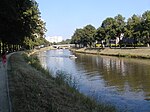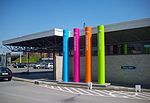Ghent Student Regatta
The Ghent Student Regatta is a boat race for students in April 2008 at Portus Ganda in the heart of historical Ghent in Dutch-speaking Flanders, Belgium, was 2008 a common initiative of Paul Van Cauwenberge, the Rector of Ghent University, in collaboration with Ghent Students Rowing the sports department of the City and Patrick Rombaut, Umpiring Commission Chairman of the Fédération Internationale des Sociétés d'Aviron (FISA). Rombaut started the Sprint idea at this location back in September 2007, where his regatta team of the annual May regatta of Ghent organised a race between the rowing teams of Christ Church Boat Club of Oxford University, Henley Rowing Club, a junior team of K.R. Club Gent/Royal Club Nautique de Gand and his own KR Sport Gent 1883 eight. The race was won in 1907 with the colours and blades of K.R.Sport Gent (Royal Sport Nautique de Gand = French name at that time) and they won again in 2007 in this 200m sprint. The idea came from the Mercedes Benz FISA World Rowing Sprints at Serpentine Lake in Hyde Park in London back in 2002. It was also a trial to bring rowing into city centers again. There are plans to continue with the enlarged version of the event every two or three years, in the same location.
Excerpt from the Wikipedia article Ghent Student Regatta (License: CC BY-SA 3.0, Authors).Ghent Student Regatta
Veermanplein, Ghent
Geographical coordinates (GPS) Address Nearby Places Show on map
Geographical coordinates (GPS)
| Latitude | Longitude |
|---|---|
| N 51.054444444444 ° | E 3.7338888888889 ° |
Address
Veermanplein
Veermanplein
9000 Ghent (Ghent)
East Flanders, Belgium
Open on Google Maps









